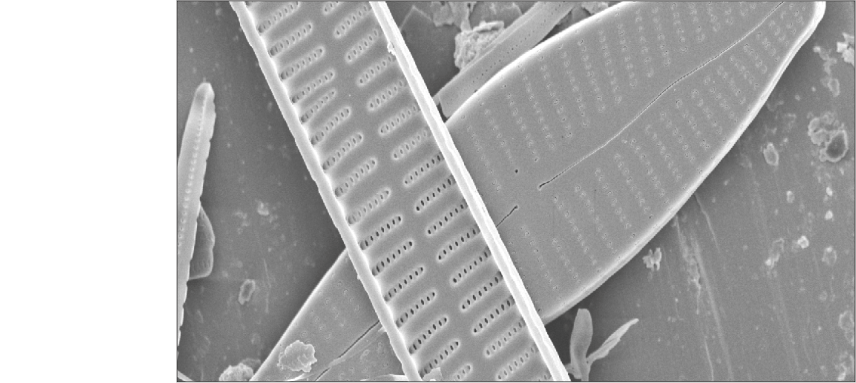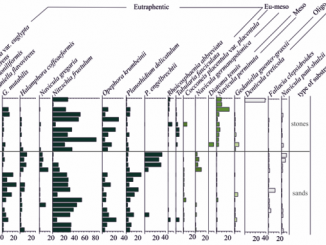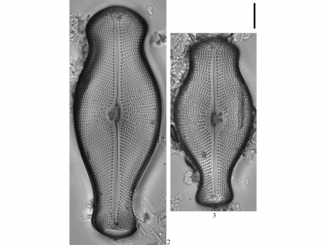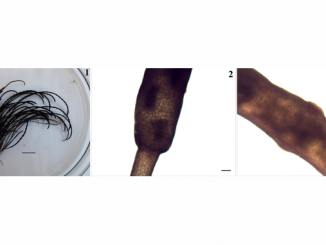
Paper category: Original research paper
Corresponding author: Teresa Noga (tnoga@ur.edu.pl)
DOI: 10.1515/ohs-2018-0004
Received: 23 June 2017
Accepted: 08 September 2017
Full text: here
Citation (APA style):
Abstract
The aim of this work was to present a morphological description and ecological characteristics of a rare species from the Gomphonema genus, occurring in calcium-rich waters, along with its new occurrence sites. The research was carried out in flowing waters of mountain and sub-mountain streams and rivers in Poland: the Wołosaty, the Wisłoka, the San and their tributaries. The occurrence of many rare and new to Polish flora species from the genus Gomphonema was recorded: G. cuneolus E. Reichardt, G. drutelingense E. Reichardt, G. innocens E. Reichardt, G. lateripunctatum E. Reichardt & Lange-Bertalot, G. lippertii E. Reichardt & Lange-Bertalot and G. calcifugum Lange-Bertalot & E. Reichardt. These species occur mostly in alkaline or close-to-neutral waters with medium or low electrolytic conductivity (78–530 µS cm−1), low nutrient content and medium-to-high calcium ion content (12.4–76.4 mg l−1). Despite the rare occurrence in other parts of the world, the studied Gomphonema species has found favorable conditions in unpolluted and calcium-rich stream beds with flysch strata. The literature data define G. calcifugum as a non-calciphilous species, but this study shows that it can develop in a wide pH range and in calcium-rich waters.
References
Bahls, L.L. (2009). A checklist of diatoms from inland waters of the northwestern United States. Proceedings of the Academy of Natural Sciences of Philadelphia 158(1): 1–35. DOI: 10.1635/053.158.0101.
Boratyn, J. & Brud, S. (1996). Szczegółowa mapa geologiczna Polski 1:50 000, ark. Dębica (979). Centralne Archiwum Geologiczne Państwowego Instytutu Geologicznego, Warszawa (In Polish).
Buszko, J. & Kiryk, F. (1995). Dębica. Zarys dziejów miasta i regionu. Wydawnictwo i drukarnia “Secesja”, Kraków, pp. 9–37 (In Polish).
Bąk, M., Witkowski, A., Żelazna-Wieczorek, J., Wojtal, A.Z., Szczepocka, E. et al. (2012). Klucz do oznaczania okrzemek w fitobentosie na potrzeby oceny stanu ekologicznego wód powierzchniowych w Polsce. Biblioteka Monitoringu Środowiska. Warszawa, Główny Inspektorat Ochrony Środowiska, pp. 1–452 (In Polish).
Cantonati, M., Corradini, G., Jüttner, I. & Cox, E.J. (2001). Diatom assemblages in high mountain streams of the Alps and the Himalaya. Nova Hedwigia 123: 37–61.
Cantonati, M., Angeli, N., Bertuzzi, E., Spitale, D. & Lange-Bertalot, H. (2012). Diatoms in springs of the Alps: springs types, environmental determinants, and substratum. Freshwater Science 31: 499–524. DOI: 10.1899/11-065.1.
Cantonati, M., Angeli, N., Spitale, D. & Lange-Bertalot, H. (2016). A new Navicula (Bacillariophyta) species from low-elevation carbonate springs affected by anthropogenic disturbance. Fottea 16(2): 255–269. DOI: 10.5507/fot.2016.013.
Celewicz-Gołdyn, S. (2006). Diatoms of the Rosnowskie Duże Lake in the Wielkopolska National Park in the years 2002 and 2003. Rocz. AR Pozn. CCCLXXVIII, Botanica Steciana 10: 11–21.
Denys, L. (2000). Historical distribution of “Red List Diatoms” (Bacillariophyceae) in Flanders (Belgium). Systematics and Geography of Plants 70(2): 409–420.
Dohet, A., Ector, L., Cauchie, H.M. & Hoffmann, L. (2008). Identification of benthic invertebrate and diatom indicator taxa that distinguish different stream types as well as degraded from reference conditions in Luxembourg. Animal Biology 58: 419–472. DOI: 10.1163/157075608X383719.
Ector, L., Wetzel, C.E., Novais, M.H. & Guillard, D. (2015). Atlas des diatomées des rivières des Pays de la Loire et de la Bretagne. DREAL Pays de la Loire, Nantes.
Ehrenberg, C.G. (1832). Über die Entwickelung und Lebensdauer der Infusionsthiere; nebst ferneren Beiträgen zu einer Vergleichung ihrer organischen Systeme. Abhandlungen der Königlichen Akademie Wissenschaften zu Berlin, Physikalische Klasse 1831: 1–154, pls I–IV.
Gesierich, D. & Kofler, W. (2010). Epilithic diatoms from rheocrene springs in the Eastern Alps (Vorarlberg, Austria). Diatom Research 25(1): 43–66. DOI: 10.1080/0269249X.2010.9705828.
Gesierich, D. & Rott, E. (2012). Is diatom richness responding to catchment glaciation? A case study from Canadian headwater streams. Journal of Limnology 71(1): 72–83.
Goma`, J., Rimet, F., Cambra, J., Hoffmann, L. & Ector, L. (2005). Diatom communities and water quality assessment in Mountain Rivers of the upper Segre basin (La Cerdanya, Oriental Pyrenees). Hydrobiologia 551: 209–225. DOI: 10.1007/s10750-005-4462-1.
Harper, M.A., Cassie Cooper, V., Chang, F.H., Nelson, W.A. & Broady, P.A. (2012). Phylum Ochrophyta: brown and golden-brown algae, diatoms, silicioflagellates, and kin. In D.P. Gordon (Ed.), New Zealand inventory of biodiversity. Volume Three. Kingdoms Bacteria, Protozoa, Chromista, Plantae, Fungi (pp. 114–163). Christchurch: Canterbury University Press.
Hofmann, G., Werum, M. & Lange-Bertalot, H. (2011). Diatomeen im Süβwasser – Benthos von Mitteleuropa. Bestimmungsflora Kieselalgen für die ökologische Praxis. Über 700 der häugfisten Arten und ihre Ökologie. In H. Lange-Bertalot (Ed.), ARG Gantner Verlag KG, Ruggell, pp. 1–908.
Hustedt, F. (1930). Bacillariophyta (Diatomeae) Zweite Auflage. In A. Pascher (Ed.), Die Süsswasser-Flora Mitteleuropas. Fischer Verlag G, Stuttgart, Jena 10: 1–466.
Ivanov, P., Kirilova, E. & Ector, L. (2006). Diatom taxonomic composition of rivers in South and West Bulgaria. Phytologia Balcanica 12(3): 327–338.
Kawecka, B. (1980). Sessile algae in european mountains streams. 1. The ecological characteristics of communities. Acta Hydrobiologica 22: 361–420.
Kawecka, B. & Sanecki, J. (2003). Didymosphenia geminata in running waters of southern Poland – symptoms of change in water quality? Hydrobiologia 495: 193–201. DOI: 10.1023/A:1025469500265.
Kociolek, J.P. (2005). A checklist and preliminary bibliography of the Recent, freshwater diatoms of inland environments of the continental United States. Proceedings of the California Academy of Sciences. Fourth Series 56(27): 395–525.
Krammer, K. & Lange-Bertalot, H. (1986). Bacillariophyceae. 1. Naviculaceae. In H. Ettl, J. Gerloff, H. Heyning & D. Mollenhauer (Eds.), Süsswasserflora von Mitteleuropa 2(1) (pp. 1–876).Fischer Verlag G, Stuttgart, New York.
Krammer, K. & Lange-Bertalot, H. (1991a). Bacillariophyceae. 3. Centrales, Fragilariaceae, Eunotiaceae. In H. Ettl, J. Gerloff, H. Heyning & D. Mollenhauer (Eds.), Süsswasserflora von Mitteleuropa 2(3) (pp. 1–576). Fischer Verlag G, Stuttgart, Jena.
Krammer, K. & Lange-Bertalot, H. (1991b). Bacillariophyceae. 4. Achnanthaceae, Kritische Ergänzungen zu Navicula (Lineolate) und Gomphonema, Gesamtliteraturverzeichnis. In H. Ettl, J. Gerloff, H. Heyning & D. Mollenhauer (Eds.), Süsswasserflora von Mitteleuropa 2(4) (pp. 1–437). Fischer Verlag G, Stuttgart, Jena.
Kukuła, K. (2002). Dorzecze Górnego Sanu i jego walory. In F. Oberc (Ed.), Zeszyty Archiwum Ziemi Sanockiej. Fundacja “Archiwum Ziemi Sanockiej”, Sanok, Zahutyń 2: 30–35 (In Polish).
Lange-Bertalot, H. (1996). Rote liste der limnischen Kieselalgen (Bacillariophyceae) Deutschlands. Schrittenreihe für Vegetationskunde 28: 633–677.
Lange-Bertalot, H. & Genkal, S.I. (1999). Diatomeen aus Sibirien I. Inseln im Arktischen Ozean (Yugorsky-Shar Strait). Iconographia Diatomologica 6: 1–271.
Levkov, Z. & Williams, D.M. (2012). Checklist of diatoms (Bacillariophyta) from Lake Ohrid and Lake Prespa (Macedonia), and their watersheds. Phytotaxa 45: 1–76. DOI: 10.11646/phytotaxa.45.1.1
Levkov, Z., Mitic-Kopanja, D. & Reichardt, E. (2016). The diatom genus Gomphonema in the Republic of Macedonia. In H. Lange-Bertalot (Ed.), Diatoms of Europe. Diatoms of the European inland waters and comparable habitats. Oberreifenberg: Koeltz Botanical Books 8: 1–552.
Noga, T., Stanek-Tarkowska, J., Pajączek, A., Peszek, Ł., Kochman, N. et al. (2013). Preliminary recognition of diatoms Bacillariophyceae of the Duszatyńskie Lakes (Western Bieszczady Mts.). Roczniki Bieszczadzkie 21: 127–146 (In Polish with English summary).
Noga, T., Kochman, N., Peszek, Ł., Stanek-Tarkowska, J. & Pajączek, A. (2014). Diatoms (Bacillariophyceae) in rivers and streams and on cultivated soils of the Podkarpacie Region in the years 2007–2011. Journal of Ecological Engineering 15(1): 6–25. DOI: 10.12911/22998993.1084168.
Noga, T., Stanek-Tarkowska, J., Rybak, M., Kochman-Kędziora, N., Peszek, Ł. et al. (2016a). Diversity of diatoms in the natural, mid-forest Terebowiec stream – Bieszczady National Park. Journal of Ecological Engineering 17(4): 232–247. DOI: 10.12911/22998993/64506.
Noga, T., Stanek-Tarkowska, J., Kloc, U., Kochman-Kędziora, N., Rybak, M. et al. (2016b). Diatom diversity and water quality of a suburban stream: a case study of the Rzeszów city in SE Poland. Biodiversity Research and Conservation 41: 19–34. DOI: 10.1515/biorc-2016-0004.
Potapova, M.G. (2006). Achnanthidium zhakovschikovii sp. nov. (Bacillariophyta) and related species from rivers of Northwestern Russia. Nova Hedwigia 82: 399–408.
Rakowska, B. (2001). Studium różnorodności okrzemek ekosystemów wodnych Polski niżowej. Wydawnictwo Uniwersytetu Łódzkiego, Łódź, pp. 1–77 (In Polish with English summary).
Reichardt, E. (1997). Taxonomische Revision des Artenkomplexes um Gomphonema pumilum (Bacillariophyceae). Nova Hedwigia 65(1–4): 99–130.
Reichardt, E. (1999). Zur Revision der Gattung Gomphonema. Die Arten um G. affine/insigne, G. angustatum/micropus, G. acuminatum sowie gomphonemoide Diatomeen aus dem Oberoligozän in Böhmen. Iconographia Diatomologica 8: 1–203.
Reichardt, E. (2001). Revision der Arten um Gomphonema truncatum und G. capitatum. In R. Jahn, J.P. Kociolek, A. Witkowski, & P. Compère (Eds.), Lange-Bertalot Festschrift. Studies on diatoms dedicated to Prof. Dr. Dr. h.c. Horst Lange-Bertalot on the occasion of his 65th birthday (pp. 187-224). Ruggell, ARG. Gantner Verlag KG.
Reichardt, E. (2015). Gomphonema gracile Ehrenberg sensu stricto et sensu auct. (Bacillariophyceae): A taxonomic revision. Nova Hedwigia 101(3/4): 367–393. DOI: 10.1127/nova_hedwigia/2015/0275.
Reichardt, E. & Lange-Bertalot, H. (1991). Taxonomische Revision des Artencomplexes um Gomphonema angustum – G. dichotomum – G. intricatum – G. vibrio und ähnliche Taxa (Bacillariophyceae). Nova Hedwigia 53(3–4): 519–544.
Rott, E., Pipp, E., Pfister, P., Van Dam, H., Ortler, K. et al. (1999). Indikationslisten für Aufwuchsalgen in Österreichischen Fließgewässern. Teil 2: Trophieindication. Bundesministerium f. Land- und Forstwirtschaft, Zahl 41.034/08-IVA 1/97, Wien, pp. 1–248.
Round, F.E., Crawford, R.M. & Mann, D.G. (1990). The Diatoms: Biology and morphology of the genera. Cambridge: Cambridge University Press, pp. 1–747.
Siemińska, J. (1964). Bacillariophyceae – Okrzemki. In K. Starmach (Ed.), Flora Słodkowodna Polski, 6. Państwowe Wydawnictwo Naukowe, Warszawa (In Polish).
Siemińska, J. & Wołowski, K. (2003). Catalogue of Polish prokaryotic and eucaryotic algae. W Szafer Intitute of Botany, Polish Academy of Sciences, Kraków, pp. 1–251.
Sieradzki, S. (2002). Geologia Doliny Sanu. In F. Oberc (Ed.), Zeszyty Archiwum Ziemi Sanockiej. Fundacja Archiwum Ziemi Sanockiej, Sanok, Zahutyń 2: 30–35 (In Polish).
Soja, R. (2009). Wody. In A. Górecki & B. Zemanek (Eds.), Magurski Park Narodowy – Monografia Przyrodnicza (pp. 55–62). Krempna, Kraków (In Polish with English summary).
Täuscher, L. (2014). Checkliste der Algen (Cyanobacteria et Phycophyta). Stand Dezember 2013. In D. Frank, & V. Neumann (Eds.), Bestandssituation der Pflanzen und Tiere in Sachsen-Anhalt. Rangsdorf.
Täuscher, L. (2016) Algen (Cyanobacteria et Phycophyta). In D. Frank & P. Schnitter (Eds.), Pflanzen und Tiere in Sachsen-Anhalt. Ein Kompendium der Biodiversität (pp. 63–112). Rangsdorf, Westermann Druck Zwickau.
Van Dam, H., Martens, A. & Sinkeldam, J. (1994). A coded checklist and ecological indicator values of freshwater diatoms from the Netherlands. Netherlands Journal of Aquatic Ecology 28(1): 117–133.
Vidaković, G., Krizmanić, J., Šovran, S. & Cvijan, M. (2016). Diatoms from a peat bog on the Pešter Plateau (Southwestern Serbia): new records for diatom flora of Serbia. Archives of Biological Sciences 68(1): 107–116. DOI: 10.2298/ABS150512132V.
Werum, M. & Lange-Bertalot, H. (2004). Diatoms in springs from Central Europe and elsewhere under the influence of hydrogeology and anthropogenic impacts. Iconographia Diatomologica, Annotated Diatom Micrographs 13: 1–417.
Whitton, B.A., John, D.M., Kelly, M.G. & Haworth, E.Y. (2003). A coded list of freshwater algae of the British Isles. Second Edition. Retrieved May 05, 2017, from http://www.nhm.ac.uk/our-science/data/uk-species/checklists/NHMSYS0000591449/index.html
Wojtal, A. (2003). Diatoms of the genus Gomphonema Ehr. (Bacillariophyceae) from a karstic stream in the Krakowsko-Częstochowska Upland. Acta Societatis Botanicorum Poloniae 27(3): 213–220.
Wojtal, A.Z. (2009). Diatom flora of the Kobylanka stream near Kraków (Wyżyna Krakowsko-Częstochowska Upland, S Poland). Polish Botanical Journal 54(2): 129–330.
Żelazna-Wieczorek, J. (2011). Diatom flora in springs of Łódź Hills (Central Poland). Biodiversity, taxonomy and temporal changes of epipsammic diatom assemblages in springs affected by human impact. Diatom Monographs 13: 1–420.




Bądź pierwszy, który skomentuje ten wpis